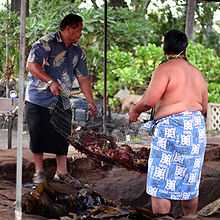Kalua
- Imu redirects here. For the acronym, see IMU.
- This article is about the Hawaiian cooking method, Kalua. For the Mexican coffee liqueur, see Kahlúa.

Kālua is a traditional Hawaiian cooking method that utilizes an imu, a type of underground oven. The word kālua, which literally means "to cook in an underground oven", may also be used to describe the food cooked in this manner, such as kālua pig or kālua turkey, which are commonly served at luau feasts. Luau, in Hawaiian is actually the name of the taro leaf, which when young and small is cooked like spinach. The traditional luau was eaten on the floor over lauhala (leaves of the hala tree were weaved together) mats.
.jpg)
Traditionally, a fire using kiawe (mesquite) wood is built in a dirt pit called the imu. The pit is usually about 6 feet (1.8 m) long, 4 feet (1.2 m) wide and 3 ft (90 cm) deep. Rocks are then placed in the pit to retain cooking heat long after the flames have burned down. Once the rocks have become extremely hot, the hole is lined with traditional vegetation, such as banana leaves. The meat to be cooked is salted, stuffed with more hot rocks, then wrapped with ti and banana leaves. To maintain even heating and to retain the meat's natural moisture, the meat is covered with wet burlap, then with a layer of sand or soil. The meat is then left to cook in the pit for six to seven hours, absorbing smoke and steam from the koa wood and banana leaves. When the meat is fully cooked, it is removed from the imu and shredded. This is done to allow the melted fat to mix with the meat to help maintain its uniform consistency and flavor.
Kālua pig is a main tourist attraction at many luaus, though it is sometimes made using a gas or electric stove with artificial mesquite or kiawe wood liquid smoke. Other tourist businesses substitute the use of rocks and leaves or use an imu pao, an above ground variation of the imu. The term "Kalua pork" has been used by famous Hawaiian cook Sam Choy to describe pork shoulder butt which is rubbed with sea salt, wrapped in ti leaves, and slowly cooked in oven using liquid mesquite smoke rather than an imu.[1]
At one time, standards enforced by the United States Department of Agriculture prevented traditional kalua pig from being sold commercially except in Hawaii.
See also
References
- ↑ "San Choy's Oven-Roasted Kalua Pig Recipe". Epicurious. February 2006.